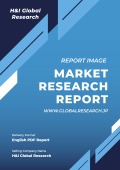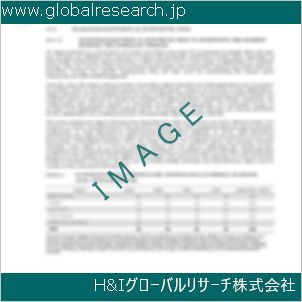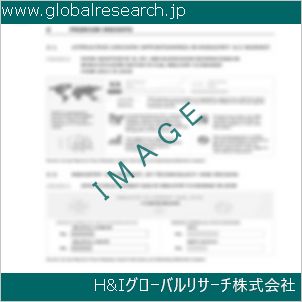目次
第1章. グローバル・フォーミュレーション添加剤市場レポートの範囲と方法論
1.1. 研究目的
1.2. 研究方法論
1.2.1. 予測モデル
1.2.2. デスク調査
1.2.3. トップダウンとボトムアップアプローチ
1.3. 研究属性
1.4. 研究の範囲
1.4.1. 市場定義
1.4.2. 市場セグメンテーション
1.5. 研究の仮定
1.5.1. 包含と除外
1.5.2. 制限事項
1.5.3. 調査対象期間
第2章 執行要約
2.1. CEO/CXOの視点
2.2. 戦略的洞察
2.3. ESG分析
2.4. 主要な発見
第3章. グローバルな配合添加剤市場動向分析
3.1. グローバルな配合添加物市場を形作る市場要因(2024–2035)
3.2. 推進要因
3.2.1. 塗料およびコーティングにおける性能向上添加物の需要増加
3.2.2. 自動車、電子機器、建設業界における工業用途の拡大
3.3. 制約
3.3.1. 化学製剤に関する厳格な規制枠組み
3.3.2. 原材料価格の変動
3.4. 機会
3.4.1. 環境対応型および低VOC添加物の採用拡大
3.4.2. ナノテクノロジーとスマート添加剤ソリューションの技術革新
第4章 グローバルな配合添加物産業分析
4.1. ポーターの5つの力モデル
4.1.1. 買い手の交渉力
4.1.2. 供給者の交渉力
4.1.3. 新規参入の脅威
4.1.4. 代替品の脅威
4.1.5. 競合企業の競争
4.2. ポーターの5つの力予測モデル(2024–2035)
4.3. PESTEL分析
4.3.1. 政治
4.3.2. 経済的
4.3.3. 社会
4.3.4. 技術的
4.3.5. 環境
4.3.6. 法的
4.4. 主要な投資機会
4.5. 主要な成功戦略(2025年)
4.6. 市場シェア分析(2024–2025)
4.7. グローバル価格分析と動向(2025年)
4.8. 分析家の推奨事項と結論
第5章. グローバルな配合添加剤市場規模と予測(タイプ別)2025–2035
5.1. 市場概要
5.2. グローバルな配合添加剤市場のパフォーマンス – 潜在分析(2025年)
5.3. 分散剤
5.3.1. 主要国別内訳推計と予測(2024–2035)
5.3.2. 地域別市場規模分析(2025~2035年)
5.4. レオロジー剤
5.4.1. 主要国別市場規模推計と予測(2024年~2035年)
5.4.2. 地域別市場規模分析、2025–2035
5.5. 湿潤剤および均一化剤
5.5.1. 主要国別市場規模推計と予測(2024年~2035年)
5.5.2. 地域別市場規模分析、2025–2035
5.6. フィルム形成剤
5.6.1. 主要国別内訳推計と予測(2024年~2035年)
5.6.2. 地域別市場規模分析、2025–2035
第6章. グローバルな配合添加剤市場規模と予測(最終用途産業別)、2025–2035
6.1. 市場概要
6.2. グローバルな配合添加剤市場のパフォーマンス – 潜在分析(2025年)
6.3. 塗料およびコーティング
6.3.1. 主要国別内訳推計と予測(2024–2035)
6.3.2. 地域別市場規模分析(2025~2035年)
6.4. 建設
6.4.1. 主要国別市場規模推計と予測(2024年~2035年)
6.4.2. 地域別市場規模分析、2025–2035
6.5. 自動車および電子機器
6.5.1. 主要国別内訳推計と予測(2024年~2035年)
6.5.2. 地域別市場規模分析、2025–2035
6.6. その他
6.6.1. 主要国別内訳推計と予測(2024年~2035年)
6.6.2. 地域別市場規模分析、2025–2035
第7章. グローバルな調製添加物市場規模と地域別予測(2025–2035年)
7.1. グローバルな配合添加物市場、地域別市場概要
7.2. 主要国および新興国
7.3. 北米の製剤添加物市場
7.3.1. アメリカ合衆国
7.3.2. カナダ
7.4. 欧州の製剤添加物市場
7.4.1. イギリス
7.4.2. ドイツ
7.4.3. フランス
7.4.4. スペイン
7.4.5. イタリア
7.4.6. その他のヨーロッパ
7.5. アジア太平洋地域 製剤添加物市場
7.5.1. 中国
7.5.2. インド
7.5.3. 日本
7.5.4. オーストラリア
7.5.5. 韓国
7.5.6. アジア太平洋地域その他
7.6. ラテンアメリカ 製剤添加物市場
7.6.1. ブラジル
7.6.2. メキシコ
7.7. 中東・アフリカ地域 製剤添加物市場
7.7.1. アラブ首長国連邦
7.7.2. サウジアラビア
7.7.3. 南アフリカ
7.7.4. 中東・アフリカその他の地域
第8章 競合分析
8.1. 主要な市場戦略
8.2. BASF SE
8.2.1. 当社概要
8.2.2. 主要な経営陣
8.2.3. 会社の概要
8.2.4. 財務実績(データ入手状況により異なります)
8.2.5. 製品/サービスポートフォリオ
8.2.6. 最近の動向
8.2.7. 市場戦略
8.2.8. SWOT分析
8.3. エボニック・インダストリーズAG
8.4. クロダ・インターナショナル・プラシフィカ
8.5. ダウ・ケミカル・カンパニー
8.6. アコゾ・ノーベル・エヌ・ブイ
8.7. ソルベイ SA
8.8. クラリアント AG
8.9. BYK-ケミカル GmbH
8.10. イーストマン・ケミカル・カンパニー
8.11. アシュランド・グローバル・ホールディングス・インク
8.12. アルケマ・グループ
8.13. エレメンティス・プラシッド
8.14. ルブリゾール・コーポレーション
8.15. ロンザ・グループAG
8.16. ハンツマン・コーポレーション
8.12. アルケマ・グループ
表の一覧
表1. グローバルな配合添加剤市場、レポートの範囲
表2. グローバルな配合添加剤市場の見積もりおよび予測(地域別)2024–2035
表3. グローバルな配合添加剤市場の見積もりおよび予測(タイプ別)2024–2035
表4. グローバルな配合添加剤市場規模推計と予測(最終用途産業別)2024–2035
表5. 米国調製添加物市場規模推計と予測、2024–2035
表6. カナダ 配合添加物市場規模予測(2024–2035年)
表7. イギリス 配合添加物市場規模予測(2024年~2035年)
表8. ドイツの配合添加物市場規模推計と予測(2024–2035年)
表9. フランス 製剤添加物市場規模予測(2024年~2035年)
表10. スペインの製剤添加物市場規模予測(2024年~2035年)
表11. イタリア 製剤添加物市場規模予測(2024年~2035年)
表12. 欧州その他の地域 製剤添加物市場規模予測(2024年~2035年)
表13. 中国の製剤添加物市場規模推計と予測(2024年~2035年)
表14. インドの製剤添加物市場規模推計と予測(2024年~2035年)
表15. 日本の製剤添加物市場規模推計と予測(2024年~2035年)
表16. オーストラリアの製剤添加物市場規模予測(2024~2035年)
表17. 韓国の製剤添加物市場規模予測(2024年~2035年)
表18. アジア太平洋地域(その他)の製剤添加物市場規模予測(2024年~2035年)
表19. ブラジル 製剤添加物市場規模予測(2024年~2035年)
表20. メキシコ 製剤添加物市場規模予測(2024年~2035年)
表21. アラブ首長国連邦(UAE)の製剤添加物市場規模推計と予測(2024~2035年)
表22. サウジアラビアの製剤添加物市場規模予測(2024年~2035年)
表23. 南アフリカ 製剤添加物市場規模予測、2024–2035
表24. 中東・アフリカ地域(その他)の製剤添加物市場規模推計と予測(2024~2035年)
図表一覧
図1. グローバル製剤添加物市場、調査方法論
図2. グローバル製剤添加物市場、市場推計手法
図3. グローバル市場規模推計および予測方法
図4. グローバルな配合添加物市場、2025年の主要な動向
図5. グローバルな配合添加剤市場、2024~2035年の成長見通し
図6. グローバルな配合添加剤市場、ポーターの5つの力モデル
図7. グローバルな配合添加物市場、PESTEL分析
図8. グローバルな配合添加物市場、バリューチェーン分析
図9. 配合添加剤市場(タイプ別)、2025年と2035年
図10. 配合添加剤市場(最終用途産業別)、2025年と2035年
図11. 北米製剤添加物市場、2025年と2035年
図12. 欧州の配合添加剤市場、2025年と2035年
図13. アジア太平洋地域 配合添加剤市場、2025年および2035年
図14. ラテンアメリカ 配合添加剤市場、2025年および2035年
図15. 中東・アフリカ 配合添加剤市場、2025年と2035年
図16. グローバル フォーミュレーション添加剤市場、企業別市場シェア分析(2025年)
Chapter 1. Global Formulation Additives Market Report Scope & Methodology
1.1. Research Objective
1.2. Research Methodology
1.2.1. Forecast Model
1.2.2. Desk Research
1.2.3. Top Down and Bottom-Up Approach
1.3. Research Attributes
1.4. Scope of the Study
1.4.1. Market Definition
1.4.2. Market Segmentation
1.5. Research Assumption
1.5.1. Inclusion & Exclusion
1.5.2. Limitations
1.5.3. Years Considered for the Study
Chapter 2. Executive Summary
2.1. CEO/CXO Standpoint
2.2. Strategic Insights
2.3. ESG Analysis
2.4. Key Findings
Chapter 3. Global Formulation Additives Market Forces Analysis
3.1. Market Forces Shaping The Global Formulation Additives Market (2024–2035)
3.2. Drivers
3.2.1. Rising demand for performance-enhancing additives in paints and coatings
3.2.2. Increased industrial applications in automotive, electronics, and construction sectors
3.3. Restraints
3.3.1. Stringent regulatory frameworks for chemical formulations
3.3.2. Volatility in raw material prices
3.4. Opportunities
3.4.1. Rising adoption of eco-friendly and low-VOC additives
3.4.2. Technological advancements in nano and smart additive solutions
Chapter 4. Global Formulation Additives Industry Analysis
4.1. Porter’s 5 Forces Model
4.1.1. Bargaining Power of Buyer
4.1.2. Bargaining Power of Supplier
4.1.3. Threat of New Entrants
4.1.4. Threat of Substitutes
4.1.5. Competitive Rivalry
4.2. Porter’s 5 Force Forecast Model (2024–2035)
4.3. PESTEL Analysis
4.3.1. Political
4.3.2. Economical
4.3.3. Social
4.3.4. Technological
4.3.5. Environmental
4.3.6. Legal
4.4. Top Investment Opportunities
4.5. Top Winning Strategies (2025)
4.6. Market Share Analysis (2024–2025)
4.7. Global Pricing Analysis And Trends 2025
4.8. Analyst Recommendation & Conclusion
Chapter 5. Global Formulation Additives Market Size & Forecasts by Type 2025–2035
5.1. Market Overview
5.2. Global Formulation Additives Market Performance - Potential Analysis (2025)
5.3. Dispersing Agents
5.3.1. Top Countries Breakdown Estimates & Forecasts, 2024–2035
5.3.2. Market Size Analysis, by Region, 2025–2035
5.4. Rheology Agents
5.4.1. Top Countries Breakdown Estimates & Forecasts, 2024–2035
5.4.2. Market Size Analysis, by Region, 2025–2035
5.5. Wetting and Levelling Agents
5.5.1. Top Countries Breakdown Estimates & Forecasts, 2024–2035
5.5.2. Market Size Analysis, by Region, 2025–2035
5.6. Film Forming Agents
5.6.1. Top Countries Breakdown Estimates & Forecasts, 2024–2035
5.6.2. Market Size Analysis, by Region, 2025–2035
Chapter 6. Global Formulation Additives Market Size & Forecasts by End-Use Industry 2025–2035
6.1. Market Overview
6.2. Global Formulation Additives Market Performance - Potential Analysis (2025)
6.3. Paints and Coatings
6.3.1. Top Countries Breakdown Estimates & Forecasts, 2024–2035
6.3.2. Market Size Analysis, by Region, 2025–2035
6.4. Construction
6.4.1. Top Countries Breakdown Estimates & Forecasts, 2024–2035
6.4.2. Market Size Analysis, by Region, 2025–2035
6.5. Automotive and Electronics
6.5.1. Top Countries Breakdown Estimates & Forecasts, 2024–2035
6.5.2. Market Size Analysis, by Region, 2025–2035
6.6. Others
6.6.1. Top Countries Breakdown Estimates & Forecasts, 2024–2035
6.6.2. Market Size Analysis, by Region, 2025–2035
Chapter 7. Global Formulation Additives Market Size & Forecasts by Region 2025–2035
7.1. Global Formulation Additives Market, Regional Market Snapshot
7.2. Top Leading & Emerging Countries
7.3. North America Formulation Additives Market
7.3.1. U.S.
7.3.2. Canada
7.4. Europe Formulation Additives Market
7.4.1. UK
7.4.2. Germany
7.4.3. France
7.4.4. Spain
7.4.5. Italy
7.4.6. Rest of Europe
7.5. Asia Pacific Formulation Additives Market
7.5.1. China
7.5.2. India
7.5.3. Japan
7.5.4. Australia
7.5.5. South Korea
7.5.6. Rest of Asia Pacific
7.6. Latin America Formulation Additives Market
7.6.1. Brazil
7.6.2. Mexico
7.7. Middle East & Africa Formulation Additives Market
7.7.1. UAE
7.7.2. Saudi Arabia
7.7.3. South Africa
7.7.4. Rest of Middle East & Africa
Chapter 8. Competitive Intelligence
8.1. Top Market Strategies
8.2. BASF SE
8.2.1. Company Overview
8.2.2. Key Executives
8.2.3. Company Snapshot
8.2.4. Financial Performance (Subject to Data Availability)
8.2.5. Product/Services Port
8.2.6. Recent Development
8.2.7. Market Strategies
8.2.8. SWOT Analysis
8.3. Evonik Industries AG
8.4. Croda International Plc
8.5. Dow Chemical Company
8.6. Akzo Nobel N.V.
8.7. Solvay SA
8.8. Clariant AG
8.9. BYK-Chemie GmbH
8.10. Eastman Chemical Company
8.11. Ashland Global Holdings Inc.
8.12. Arkema Group
8.13. Elementis Plc
8.14. Lubrizol Corporation
8.15. Lonza Group AG
8.16. Huntsman Corporation
❖ 免責事項 ❖
http://www.globalresearch.jp/disclaimer












